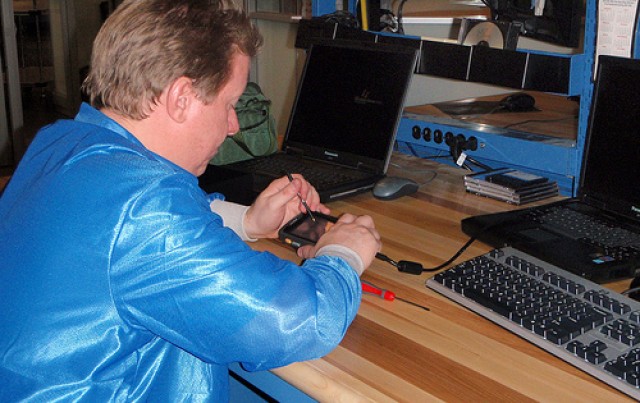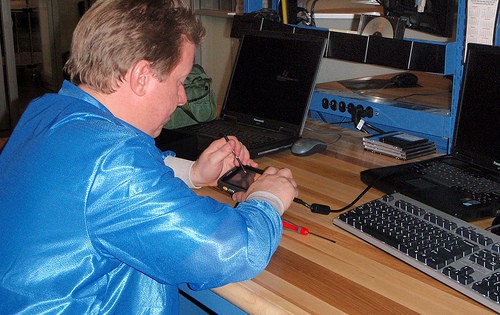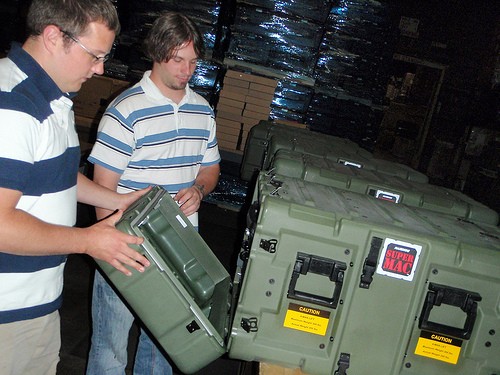After World War II, newlyweds flocked to the tranquil surroundings of the Pocono Mountains in northeast Pennsylvania. The area became known as the "Honeymoon Capital of the World." Today, the area is a year-round vacation destination. In this quiet setting is the largest full-service electronics maintenance facility in the Department of Defense, Tobyhanna Army Depot (TYAD).
The rural surroundings mask the flurry of activity on the 1,296-acre campus. TYAD plays a role in the success of nearly every military mission via the design, fabrication, repair and overhaul of electronic systems.
In 2005, Medical Communications for Combat Casualty Care (MC4) joined the ranks of Tobyhanna-supported programs. A partnership between the two organizations helps MC4 support the electronic medical recording (EMR) and medical logistics initiatives and leverage TYAD's robust storage facilities, global systems repair and technical fulfillment services. Col. Ron Alberto, former commander of TYAD from July 2006 to July 2009, says it is the depot's vast maintenance and sustainment capabilities that make the facility truly unique.
"We are at the very forefront of depot maintenance and logistics operations," Col. Alberto said at the July unveiling of the new Depot Maintenance of the Future (DMOF) facility. "Nowhere else in the public or private sector is there a facility that can do everything we do here."
MC4 has fielded more than 30,000 ruggedized laptops, servers, handheld devices and printers to hundreds of units around the world enabling the collection of medical data on the battlefield. TYAD has ensured those mission-critical systems end up in the hands of deployed medical forces.
Resembling a neighborhood wholesale store, ruggedized cases packed with MC4 equipment fill heavy duty metal shelves towering nearly 30 feet tall. The sea of black cases consumes a warehouse facility equal to three-quarters of an acre.
"Orders are typically processed and shipped the same day they come in," said Steve Kulick, MC4's lead warehouse analyst. "It doesn't matter if an order comes in from a unit deploying to Afghanistan or preparing to support humanitarian relief efforts, such as Joint Task Force Katrina. Our efforts at Tobyhanna have supplied MC4 systems to units in 14 countries to date."
Global System Repair
The high temperatures and dusty conditions of Southwest Asia (SWA) wreck havoc with the computers and other sensitive equipment used by warfighter. Periodic repair is a reality. Before 1994, deployed units dealt with long turnaround times waiting for the fixed gear to return from the stateside depot.
Today, wait times are significantly reduced thanks in part to the establishment of TYAD's forward repair
activities (FRAs), including several FRAs in SWA. As a result, Tobyhanna's technical staff is closer to the troops. Since 2005, the FRAs have supported more than 10,000 MC4 systems.
"We export all of Tobyhanna's capabilities worldwide through our global network of FRAs," Col. Alberto said. "We have hundreds of our technicians accomplishing missions around the globe-in the combat zone or embedded with units serving in garrison."
MC4 Included in Tobyhanna's Latest Test Facility
Since TYAD opened in 1953, the drive for process improvement has been constant. This is stressed to the approximately 6,000 men and women who work at TYAD, providing the highest level of systems support possible to warfighters.
In July, the TYAD team supporting the MC4 program moved into the DMOF, TYAD's latest high tech test lab. New processes forged in the lab will be shared with other teams at Tobyhanna to create best practices.
"MC4 was selected for inclusion within the DMOF because of the program's state-of-the-art equipment used by Soldiers," said Jerry Dougher, TYAD command, control, computers (C3) division chief. "Here, we image several hundred laptops and handhelds every week. We also have the ability to double our weekly production to meet mission requirements."
Over the past year, the MC4 team developed a new process to connect multiple laptops to a server to integrate the required EMR software. As a result, the timeline reduced from 40 minutes to image one laptop via CD-ROM to 20 minutes to complete up to 24 computers at the same time. Additionally, they reduced the probability of software errors. The team also implemented a similar method for batch processing memory cards used in MC4 handheld devices.
The new working environment offers the MC4 team additional room to operate, as well as new features to keep them focused on the job at hand. A conveyor belt moves hardware throughout the lab and automatically stops at specific workstations based upon the hardware transported. Stephen Laskowski, electronics technician at TYAD supporting MC4 says this is only the beginning.
"The team has been given a blank canvas to continue to improve the work that we do," Laskowski said. "The processes we uncover, both big and small, will help us improve the efficiency and quality of our work. In turn, our efforts can help other groups in the depot better support their customers."
For more information regarding the systems integration and fielding efforts surrounding the U.S. military's tactical electronic medical recording system, visit <a href="http://www.mc4.army.mil">www.mc4.army.mil</a>.




Social Sharing